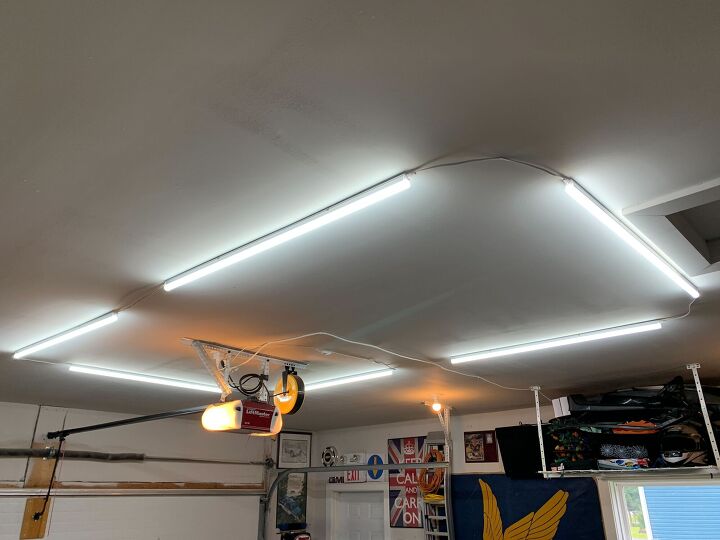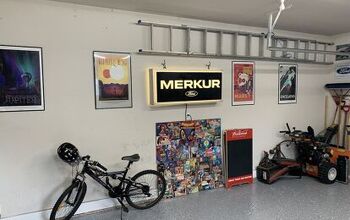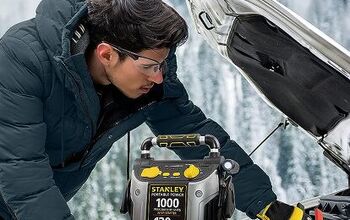Stuff We Use: What’s the Best Garage Lighting?

On our never-ending quest to improve this place by listening to feedback from the B&B, we are taking a new tack with these product posts, choosing instead to focus on items we use and have purchased with our own meager income. After all, if we’re giving you the truth about cars, we ought to give you the truth about car accessories.
If you count yourself amongst the few with a covered garage in which to wrench on yer hooptie, this post will – as the kids say – be relevant to your interests. If not, read on anyways because just about every nook and cranny of one’s home could stand to receive a dash of extra illumination.
Thanks to the scourge of so-called high-efficiency lighting – or perhaps it is age and eyesight which seem to be inversely proportional as I blast beyond my 43rd trip around the sun – it never seems to be bright enough in my garage. Bolts fly off into dark corners, never again to see the light of day, and I am certain there is a goblin somewhere that takes all my 10mm sockets and spirits them away to another dimension.
After hearing me wrestle with and complain about finding a car’s proper lift points on which to exert the force of my Motomaster floor jack, the Other Half wisely (and firmly) recommended I find new lighting solutions for our two-car attached space. And when I say ‘recommended’, what I actually mean is ‘vehemently instructed’. Anyone in the B&B with a spouse or long-term partner knows exactly what we’re on about.
Seven investigations later, our Amazon account was laden with the purchase of LED lighting strips from a brand called Barrina. Various and sundry social media groups filled with gearheads were awash with recommendations for this brand, as were a number of (shudder) online forums. The company has its own storefront on Amazon, helping dissuade fears of third-party sellers which have a tendency to either abscond with your money or take eleventy billion years to ship the product.
Given the dimensions of the garage, a six-pack of four-foot lights was chosen, though different quantities and lengths are available. I don’t recall being outraged by waiting for them, so its delivery time must have been reasonable. What appeared was a long and narrow box, decently packed to guard against damage and festooned with the Barrina logo. Good job it wasn’t anything embarrassing (that shows up next week).
Here’s where the first pleasant surprise appeared. Each 4-foot LED light bar came with its own choice of power supply: An individual clicky switch to plug directly into a household socket, properly stripped connections to wire into a building’s existing light network, or a proprietary cord to daisy chain the LED bars together and form one big circuit. The latter is what I chose to deploy, arranging each bar in a rectangle on the ceiling, centered in the middle of my garage.
Installation couldn’t have been simpler. Each bar weighs about as much as a feather and comes with two mounting clips. I screwed each clip into the ceiling’s drywall (some into framing studs, some not) and easily pushed the lights into their new home. Those daisy chain cords were then used to link them all together, terminating with one cord that could be plugged into a household socket. My garage has an outlet on the ceiling for an electric garage door opener, making things very convenient. In fact, the most arduous part of the installation was making sure my measurements were correct so the rectangle I was attempting to make was vaguely square and centered.
One item I did add was a wireless on/off switch that plugs into the electrical socket and is controlled by a remote switch. This gadget essentially just interrupts power from the socket on demand, allowing me to turn the six lights on without reaching up to flip the switch on the terminating cord. Look at the pictures for a visual clue of what I’m trying to describe.
Light coming from these things is clear, bright, and illuminates the 24x24 space better than the four standard bulbs ever could. They’ve been up there for about a year and show no sign of movement or lessening their grip on the ceiling, marking this as one of the best sub-$100 purchases I’ve ever made.
The beauty of this kit lies in the sheer number of connection options. If a person wants to put four of the LED bars on the ceiling but plug two more into a different spot – say, near their toolbox or workbench – it is easy to do so. Wiring them into an existing household grid should probably be handled by a pro but the necessary items are present for that task as well. Color me satisfied.
As planned, this series of posts will continue to focus on items we’ve actually used and bought with our own money. We hope you found this one helpful.
[Images: Manufacturer, the author]
Become a TTAC insider. Get the latest news, features, TTAC takes, and everything else that gets to the truth about cars first by subscribing to our newsletter.

Matthew buys, sells, fixes, & races cars. As a human index of auto & auction knowledge, he is fond of making money and offering loud opinions.
More by Matthew Guy
Latest Car Reviews
Read moreLatest Product Reviews
Read moreRecent Comments
- Ajla Remember when Cadillac introduced an entirely new V8 and proceeded to install it in only 800 cars before cancelling everything?
- Bouzouki Cadillac (aka GM!!) made so many mistakes over the past 40 years, right up to today, one could make a MBA course of it. Others have alluded to them, there is not enough room for me to recite them in a flowing, cohesive manner.Cadillac today is literally a tarted-up Chevrolet. They are nice cars, and the "aura" of the Cadillac name still works on several (mostly female) consumers who are not car enthusiasts.The CT4 and CT5 offer superlative ride and handling, and even performance--but, it is wrapped in sheet metal that (at least I think) looks awful, with (still) sub-par interiors. They are niche cars. They are the last gasp of the Alpha platform--which I have been told by people close to it, was meant to be a Pontiac "BMW 3-series". The bankruptcy killed Pontiac, but the Alpha had been mostly engineered, so it was "Cadillac-ized" with the new "edgy" CTS styling.Most Cadillacs sold are crossovers. The most profitable "Cadillac" is the Escalade (note that GM never jack up the name on THAT!).The question posed here is rather irrelevant. NO ONE has "a blank check", because GM (any company or corporation) does not have bottomless resources.Better styling, and superlative "performance" (by that, I mean being among the best in noise, harshness, handling, performance, reliablity, quality) would cost a lot of money.Post-bankruptcy GM actually tried. No one here mentioned GM's effort to do just that: the "Omega" platform, aka CT6.The (horribly misnamed) CT6 was actually a credible Mercedes/Lexus competitor. I'm sure it cost GM a fortune to develop (the platform was unique, not shared with any other car. The top-of-the-line ORIGINAL Blackwing V8 was also unique, expensive, and ultimately...very few were sold. All of this is a LOT of money).I used to know the sales numbers, and my sense was the CT6 sold about HALF the units GM projected. More importantly, it sold about half to two thirds the volume of the S-Class (which cost a lot more in 201x)Many of your fixed cost are predicated on volume. One way to improve your business case (if the right people want to get the Green Light) is to inflate your projected volumes. This lowers the unit cost for seats, mufflers, control arms, etc, and makes the vehicle more profitable--on paper.Suppliers tool up to make the number of parts the carmaker projects. However, if the volume is less than expected, the automaker has to make up the difference.So, unfortunately, not only was the CT6 an expensive car to build, but Cadillac's weak "brand equity" limited how much GM could charge (and these were still pricey cars in 2016-18, a "base" car was ).Other than the name, the "Omega" could have marked the starting point for Cadillac to once again be the standard of the world. Other than the awful name (Fleetwood, Elegante, Paramount, even ParAMOUR would be better), and offering the basest car with a FOUR cylinder turbo on the base car (incredibly moronic!), it was very good car and a CREDIBLE Mercedes S-Class/Lexus LS400 alternative. While I cannot know if the novel aluminum body was worth the cost (very expensive and complex to build), the bragging rights were legit--a LARGE car that was lighter, but had good body rigidity. No surprise, the interior was not the best, but the gap with the big boys was as close as GM has done in the luxury sphere.Mary Barra decided that profits today and tomorrow were more important than gambling on profits in 2025 and later. Having sunk a TON of money, and even done a mid-cycle enhancement, complete with the new Blackwing engine (which copied BMW with the twin turbos nestled in the "V"!), in fall 2018 GM announced it was discontinuing the car, and closing the assembly plant it was built in. (And so you know, building different platforms on the same line is very challenging and considerably less efficient in terms of capital and labor costs than the same platform, or better yet, the same model).So now, GM is anticipating that, as the car market "goes electric" (if you can call it that--more like the Federal Government and EU and even China PUSHING electric cars), they can make electric Cadillacs that are "prestige". The Cadillac Celestique is the opening salvo--$340,000. We will see how it works out.
- Lynn Joiner Lynn JoinerJust put 2,000 miles on a Chevy Malibu rental from Budget, touring around AZ, UT, CO for a month. Ran fine, no problems at all, little 1.7L 4-cylinder just sipped fuel, and the trunk held our large suitcases easily. Yeah, I hated looking up at all the huge FWD trucks blowing by, but the Malibu easily kept up on the 80 mph Interstate in Utah. I expect a new one would be about a third the cost of the big guys. It won't tow your horse trailer, but it'll get you to the store. Why kill it?
- Lynn Joiner Just put 2,000 miles on a Chevy Malibu rental from Budget, touring around AZ, UT, CO for a month. Ran fine, no problems at all, little 1.7L 4-cylinder just sipped fuel, and the trunk held our large suitcases easily. Yeah, I hated looking up at all the huge FWD trucks blowing by, but the Malibu easily kept up on the 80 mph Interstate in Utah. I expect a new one would be about a third the cost of the big guys. It won't tow your horse trailer, but it'll get you to the store. Why kill it?
- Ollicat I am only speaking from my own perspective so no need to bash me if you disagree. I already know half or more of you will disagree with me. But I think the traditional upscale Cadillac buyer has traditionally been more conservative in their political position. My suggestion is to make Cadillac separate from GM and make them into a COMPANY, not just cars. And made the company different from all other car companies by promoting conservative causes and messaging. They need to build up a whole aura about the company and appeal to a large group of people that are really kind of sick of the left and sending their money that direction. But yes, I also agree about many of your suggestions above about the cars too. No EVs. But at this point, what has Cadillac got to lose by separating from GM completely and appealing to people with money who want to show everyone that they aren't buying the leftist Kook-Aid.




































Comments
Join the conversation
Obviously, it depends on the type of garage, especially the ceiling and walls. I don't have a garage, but rented one, below an upstairs apartment.
It had plaster walls and ceiling, and a previous user had installed silver foil wallpaper on the ceiling, and spliced into the single bare lightbulb in the center to create a line of three bare lightbulb bases. He finished it off with three 23-watt (100 watt equivalent) spiral fluorescent bulbs, all turned on/off with one switch.
It was very bright, mostly because the walls were semi-gloss white. That was acceptable for exterior cleaning/polishing, but for under-hood or under-car work, there's no substitute for a portable light, one you can put on the floor or hang from a hook, as needed.
For bench work, that's another situation entirely. That's the key: different lighting solutions for different situations.
• If you have one or more of ye olde E26 medium-base lampholder light sockets on the ceiling, the newfangled 'deformable'/adjustable "garage lights" (3 panels or you can go crazy with more) are a natural first step to take. 5000K ('daylight') color temperature is good for your garage. Adjust the tilt of the panels to cover your previously darkened corners.
• Next would be your linkable LED lights in whatever form factor you like. 5000K. Get twice as many as you think you want, plus some spares for when they burn out several years from now and they don't make those exact ones anymore.
• Then two or more good old-fashioned swing-arm work lamps (ex. Ikea Tertial) with modern 100W equivalent LED bulbs (5000K). Mount them on the *wall* over your benches. Close-up and adjustable task lighting.
• Now circle back around and replace any non-5000K bulbs in the garage door opener or wherever. Make it all match (pretty!).
• Then you have your rechargeable portable/magnetic work lights in various styles. Check out the Icon 59170 (Snap-On knockoff) for one example.